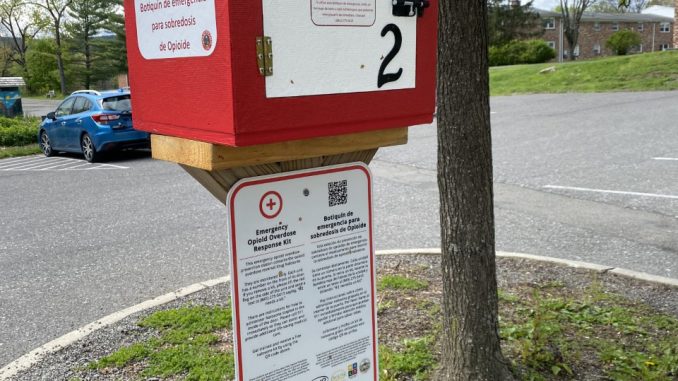
The New York State Department of Health found that Ulster County had an overdose rate of 30.4 overdoses per 100,000 people in 2020, above the New York State rate (excluding New York City) of 21.4 per 100,000 people. Ulster County was number two in the state for opioid overdoses and opioid overdose deaths, second to Sullivan County.
The New Paltz Opioid Overdose Prevention Team (NPOORT) has developed outdoor opioid overdose kit stations to counter the growing overdose rate in Ulster County. Two of the 10 stations planned have been installed: one outside of the New Paltz Community Center and one near the new footbridge by Moriello Pool.
The stations, which are red boxes modeled after Free Little Libraries, each contain two overdose prevention kits. The kits include naloxone — a one-way breathing shields for rescue breaths, gloves and instructions on how to administer the medication. Instructions on how to use the kits are also stapled on the inside of the station door, in both English and Spanish. The NPOORT monitors the stations daily. The stations have a flag that can be raised to notify the NPOORT that a kit has been used and a refill is needed. Signs attached to the posts of the stations display the number that should be texted along with raising the flag to notify the NPOORT that a refill is needed.These signs also have a QR code that brings users to a website that offers free Narcan training, Narcan kits and fentanyl testing strips.
The outdoor stations are part of a wider initiative to have easily-accessible naloxone in key places in New Paltz. There have been 16 indoor overdose prevention kit stations installed in businesses and municipal offices. Hudson Valley One reported that these indoor prevention kits can be found in Bacchus Restaurant, The Bakery, Elting Memorial Library, Karma Road, McGillicuddy’s, New Paltz Town Hall, the New Paltz Police Department, the New Paltz Community Center, the New Paltz Highway Department, the New Paltz Youth Center, the Visitors’ Center at One EPIC Place, P&G’s, Redeemer Lutheran Church, Schatzi’s Pub, Snug Harbor and Water Street Market.
The new outdoor stations address the need for accessible naloxone for remote locations and for when the buildings that host the indoor stations are closed, especially at night.
Phoenix Kawamato, MSW, director of the Town of New Paltz Office for Community Wellness, told The Oracle that the remaining eight outdoor stations are planned to be installed within a month in both the Town and the Village of New Paltz. Six of the remaining locations have already been determined. In the Village, three stations will be located along the Wallkill Valley Rail Trail, one will be located in Hasbrouck Park and one will be located at the Dr. Margaret Wade-Lewis Black History Cultural Center. Along with the two stations recently installed in the Town, the Town is set to have another station in the Field of Dreams Park on Libertyville Road. Kawamato said the last two locations will be confirmed shortly.
The locations of the stations and the focus of other overdose prevention efforts are informed by data collected from the Emergency Medical System, as well as anecdotal data from law enforcement. Ulster County is a High-Intensity Drug Trafficking Area, a classification which gives the county access to additional data and mapping. “We have the ability to look in real time where overdoses are tending to occur and try to target resources and response,” Kawamoto said.
The stations were created by the NPOORT in partnership with numerous organizations, including the Town of New Paltz, the Village of New Paltz, Bruderhof, the New Paltz Police Department, the New Paltz Youth Program, Thriving Together and Wallkill Valley Land Trust. A main consideration for the outdoor stations was the effect of extreme temperatures on naloxone. Kamamoto found in FDA studies that naloxone remains 90% effective after enduring freezing and thawing cycles or temperatures above 104 degrees. Kamamoto brought the idea for an insulated box to Bruderhof, who then created a prototype. Wallkill Valley Land Trust provided the signs attached to the posts of the stations.
The stations are strategically located in places most likely for opioid use and overdose. For example, the New Paltz Community Center has two stations – one indoor and one outdoor. “This is an indoor/outdoor location because this community center is open to the public, public restrooms, there’s not a lot of people around. Never know,” Kamamoto said. The other outdoor station near Moriello Pool was installed on a foot trail next to a bench. The station that will be in Hasbrouck Park will be installed next to the gazebo in the corner of the field. The NPOORT intends to install the stations in locations such as these, though they must obtain digging permits and abide by the presence of underground gas and electrical lines.
Narcan kits have already been used at the two new outdoor stations. Kamamoto said that through overdose prevention efforts there has been a reduction in the number of fatal overdoses in Ulster County. However, according to Kamamato, non-fatal overdoses continue to rise.
In 2022, New York’s Governor Hochul signed legislation that requires all public colleges to carry opioid antagonist medications and have RA’s be trained to administer the medication in the event of an overdose. In January, Kamamoto worked with SUNY New Paltz’s College Prevention Coordinator Jaclyn Cirello to train the campus’ RAs in naloxone administration. There are naloxone kits in every residential hall, as well as next to the welcome desk in the AWC, in the basement-floor pool entrance of the Elting Gym, in the basement of HAB, in the first-floor food court of the Student Union Building, in the main lobby and in the lower level of the Library and on the first floor of the Dining Hall by the bathrooms.
